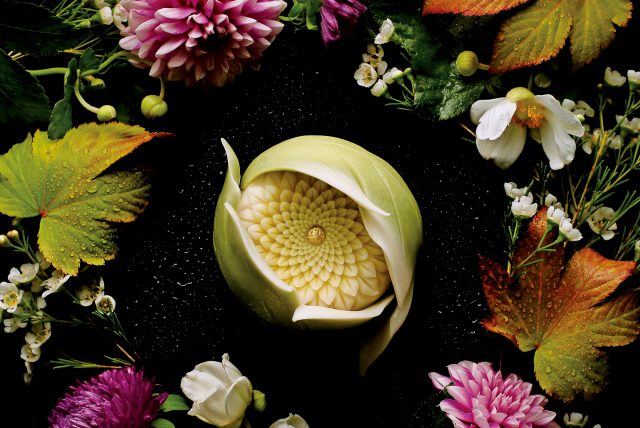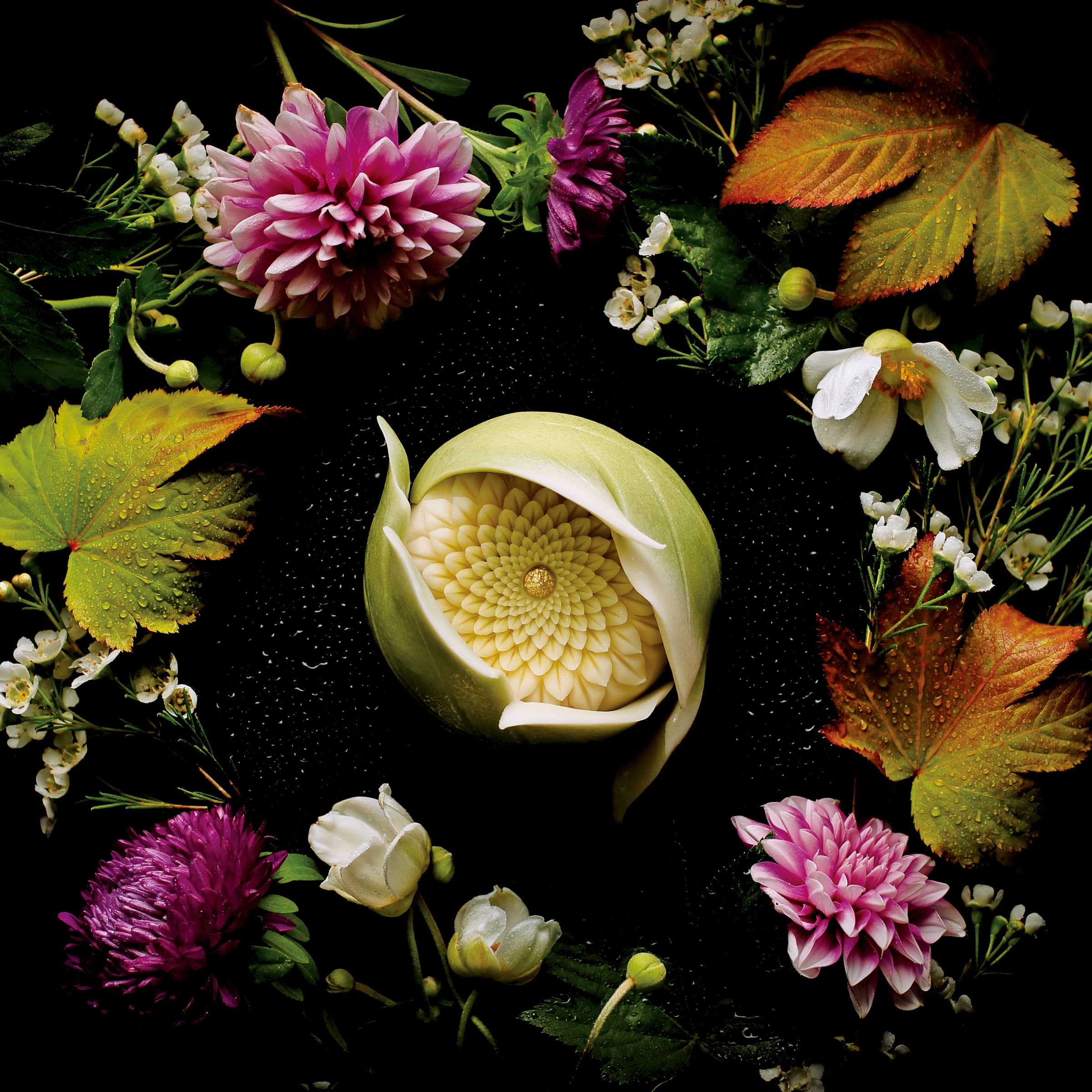An Affection for Wagashi Transcending National and Generational Boundaries: The French Chocolatiers Enchanted by the “Way of Sweets”
As Junichi Mitsubori travels the world promoting wagashi culture through innovative self-expression, he has found many kindred souls who admire his spirit and creativity. One of these is the renowned French chocolatier Nicolas Bernardé, recipient of the France’s highest honor for artisans, the MOF, who runs a chic pâtisserie in a quiet town in the suburbs of Paris.
“I met Junichi Mitsubori three years ago, when he started working as a wagashi instructor at my store,” says Bernardé. “I learned of the huge amount of unseen effort that goes into making the sweet, delicate wagashi we know, such as the necessity of kneading the azuki beans slowly. His technique for creating these elegant sweets, using his own sensibilities as tools, are astonishing, and I learned a great deal.”
Mitsubori recalls his first meeting with Bernardé at the Salon du Chocolat well. “He tried some nerikiri made with amazake from Dassai,” says Mitsubori. “Nicolas Bernardé is beloved by his community; he has a respect for people and a deep affection for both cooking and confectionery. This is all evident in the pastries and chocolate he makes. Japan and the West have different forms of expression, but the way we feel about our tools and culinary creations is exactly the same. He is my most respected mentor in the world of sweets.”
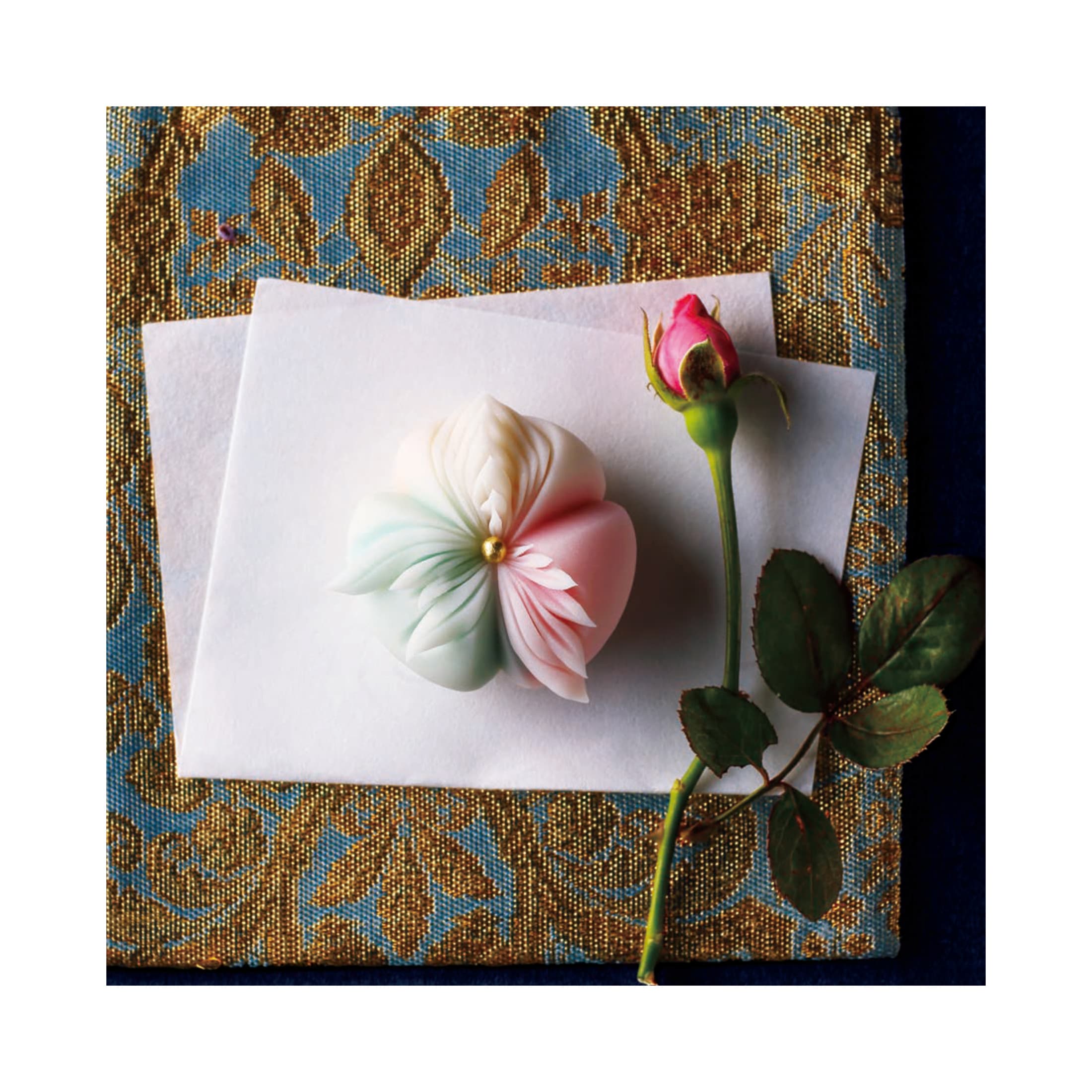

This wagashi was inspired by France. It symbolizes the national motto of “Liberty, equality, fraternity”
“Kadou” or the “Way of Sweets” was developed by Mitsubori in order to convey wagashi to the world in a new form. Its roots lie in the tea ceremony (literally known as the “Way of Tea” in Japanese), specifically the “warrior school” (buke-ryu) of tea. Mitsubori’s goal is to bring the ideals of the tea ceremony, once a pastime for warriors, into the modern-day world of confectionery. He sees this warrior image, as well as the spirit of European chivalry, in Bernardé’s warm and sincere character and focused creativity and approach to the work, and the two encourage each other as they pursue their visions.
Tradition Amidst Innovation: A Sensibility of Shadows
Asked about the Japanese sensibilities he hopes to convey to the people of the world through wagashi, Mitsubori immediately identifies the concepts of wabi and sabi that lie at the root of the country’s aesthetics. Though difficult to translate, wabi and sabi essentially evoke the beauty of rustic simplicity and palpable impermanence.
“The sensibilities of wabi and sabi can be found throughout the countries of Asia, but I believe that they were polished to a high degree in Japan, which closed itself off from the rest of the world to a certain extent during the Edo period (1603-1868).”
For example, Mitsubori explains, if Western sweets are like the sun, designed to thrill and excite the heart, wagashi are like the moon, drawing the heart in with the promise of peace and solace.
Mitsubori places great importance on the deep sentiment inherent in wagashi—a testament to his long years of practice and reflection on the sweets he creates.
“To borrow an idea from Jun’ichiro Tanizaki’s In Praise of Shadows, wagashi have a certain shadowy aspect. They might be soft or sharp, but I feel that Japanese people have found peace and tranquility even in those little shadows.”
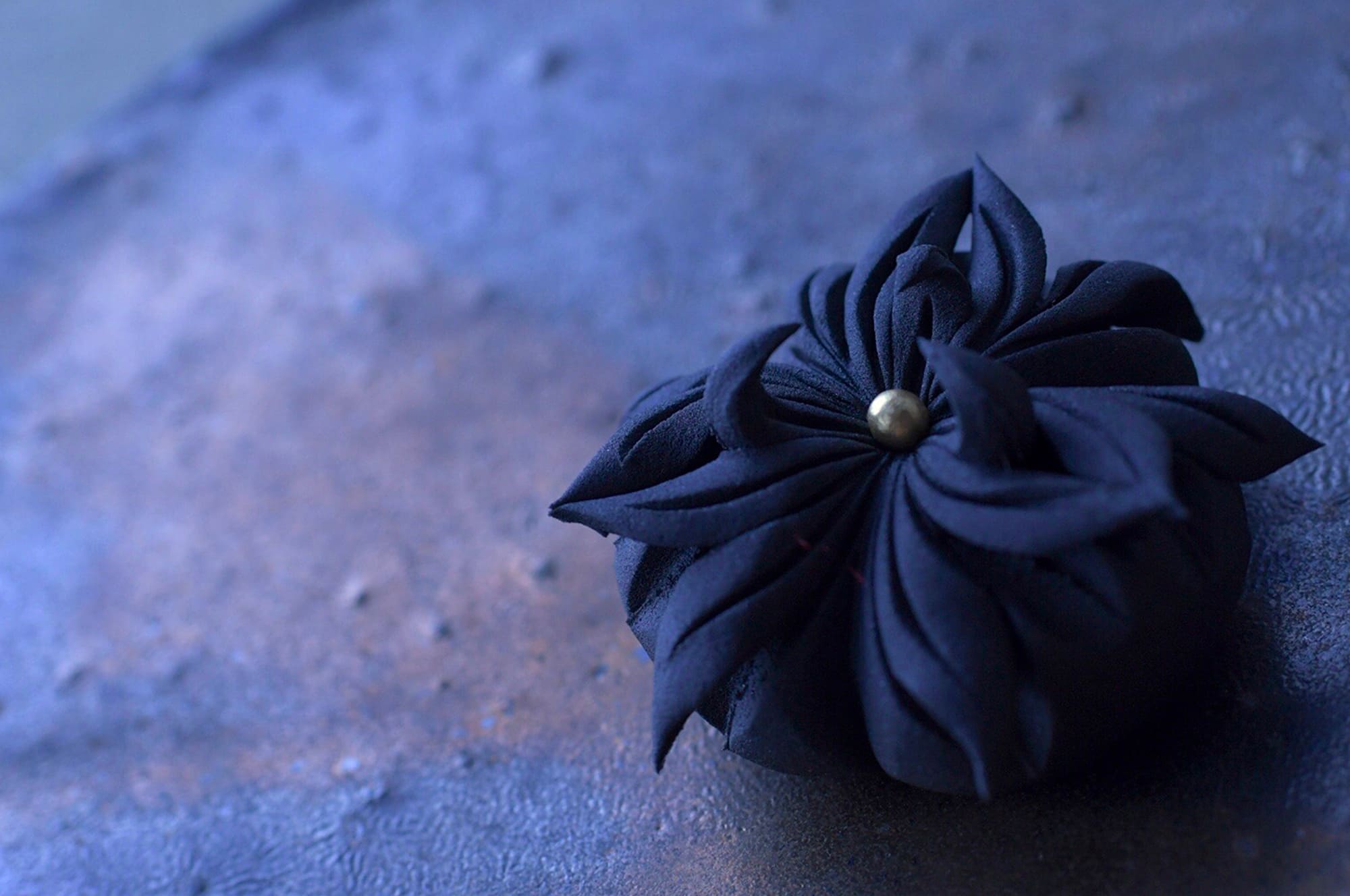

“Tripedal Crow,” one of Mitsubori’s iconic creations


“Rose” is as lovely and delicate as its wild namesake.
Another concept falling within the domain of wabi and sabi is impermanence. “Unlike a culture built on stone, Japan’s culture of wood and paper means that objects inevitably decay and finally disappear. A spirituality encompassing sympathy or empathy with this condition, and the desire to give your all even to the most fleeting things—I think this is also a very Japanese idea. Confectionery is fleeting too. Wabi and sabi express the understanding that anything with life must one day pass away.”
What does the future hold for Mitsubori and the world of wagashi?
“Being outside Japan so much, I have developed a strong desire to feel pride in my country’s culture. Wagashi are changing rapidly, but I am determined to hand down the tradition that was handed down to me—to act as a humble custodian of knowledge, accepting it and passing it on to those who come after. Conveying the wonder of wagashi to Japanese people today is really no different from conveying it to people from outside Japan. That is exactly why I aim to keep it alive not just as food culture but also as a culture that people can experience for themselves.”
In future, Mitsubori explains, he hopes to stage even more events in spaces that can themselves resonate with the performance: castles, churches, temples, museums, and the like. “Wagashi are small, but I believe each one has infinite power to represent space and time, the human heart, and the Japanese aesthetic tradition—both old and new—in miniature.”
Wagashi today
The word wagashi has two components: Wa, meaning “Japanese,” and kashi, which in ancient times referred to fruits and nuts. Over the centuries, everything from the transmission of Buddhism to the arrival of ships from Portugal brought a variety of different sweets from around the world to the shores of Japan, and soon kashi made with native ingredients appeared as well. Well-known types of wagashi like manju (bean paste buns), rakugan (hard candy made from sugar and flour), and yokan (bean paste jelly) all took their current forms from the fourteenth to the sixteenth century, as Japan entered its peaceful, flourishing Edo Period
With the development of the tea ceremony and the rise of Genroku culture in the late seventeenth to early eighteenth century, wagashi diversified. They became beautiful to look at as well as delicious to eat, and were offered to guests along with tea, sometimes glamorous and splendid, sometimes modest and unassuming tea. Old favorites remained in favor, but cultures and ingredients from outside Japan also provided new inspiration for both forms and flavors, and wagashi continue to evolve today.
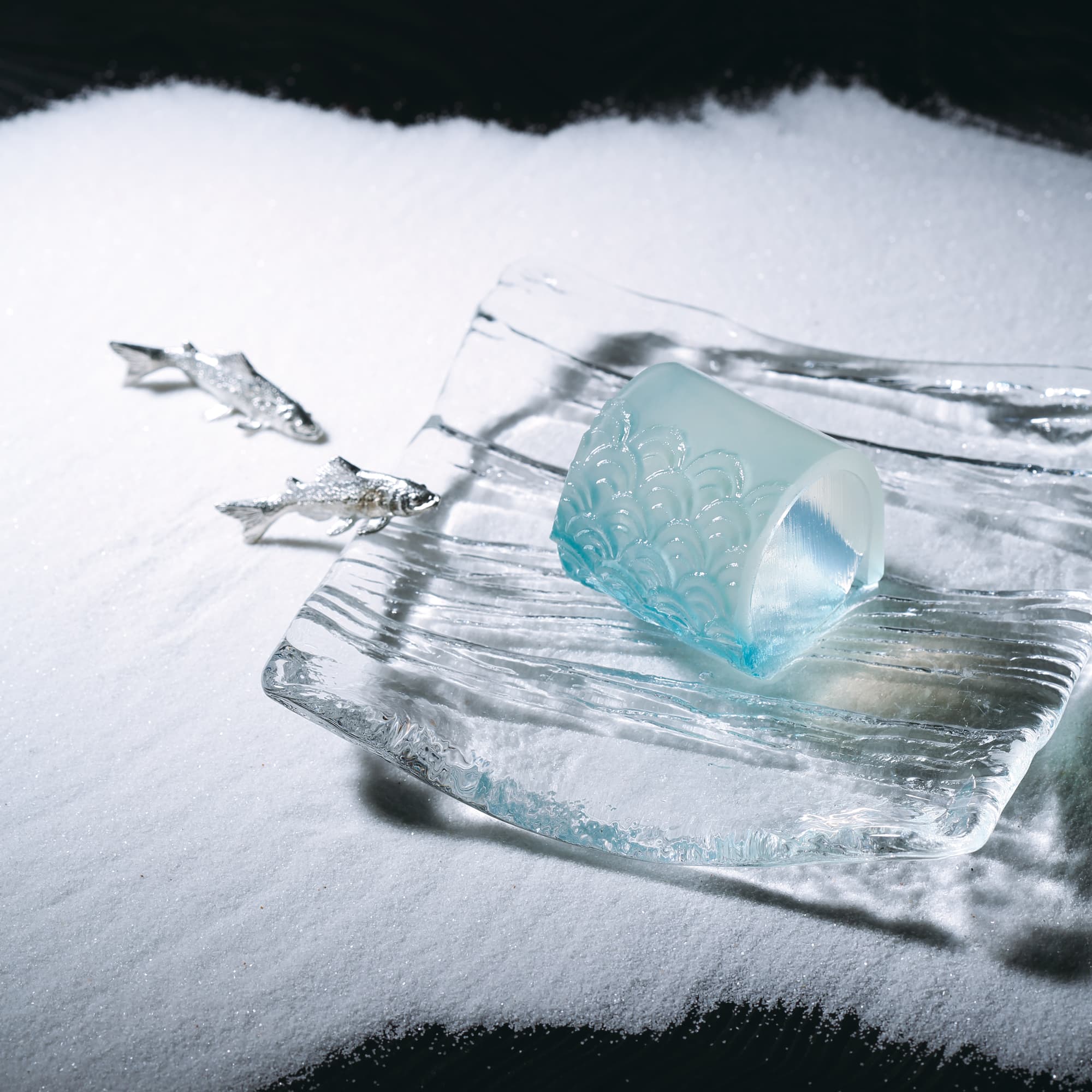

“Wave” uses kingyokukan, made with kanten and sugar, to give the impression of liquidity.
Notwithstanding this long evolution, wagashi have remained in the shadows, enjoyed in the hushed atmosphere of tea rooms or with friends and family at home. Junichi Mitsubori’s bold approach of turning wagashi creation into a performance where creativity resonates with the space itself, represents a new stage in the history of this traditional delicacy.
Junichi Mitsubori
Head of Kadou Ichika-Ryu
Born 1974 in Yokosuka, Kanagawa. After graduating from Tokyo Confectionery School, took up the family trade of wagashi and inherited the Izumiya store in Yokosuka as the third-generation owner in 2003. Creates wagashi with the same attention to beauty of action as seen in the tea ceremony, and strives to promote Kadou—the “way of sweets”—both within Japan and around the world through nerikiri workshops and other activities.
Photography ©︎ Junichi Mitsubori , Wagashi-Izumiya
Special Thanks to Kanami Okimura , Mitsukoshi-Isetan

